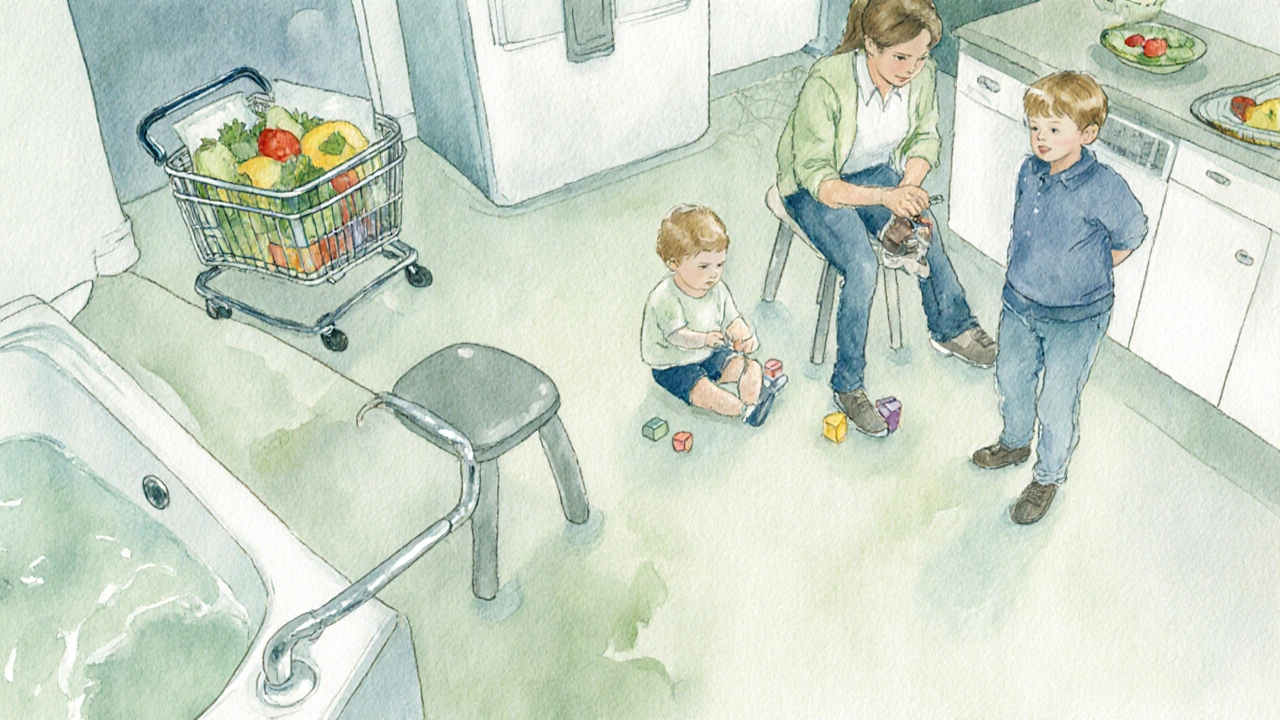Parenting with Myasthenia Gravis: Practical Tips & Strategies
 Oct, 8 2025
Oct, 8 2025
Parenting with Myasthenia Gravis: Daily Strategy Planner
Energy Management
Medication Reminder
Safety Precautions
Self-Care Moment
Quick Tips Summary:
Living with Myasthenia Gravis is a daily balancing act, especially when you’re also raising children. The unpredictable muscle weakness and tiring flare‑ups can make simple routines feel like a marathon. Below you’ll find real‑world tactics that let you keep the lights on at home, stay engaged with your kids, and protect your own well‑being.
What is Myasthenia Gravis?
Myasthenia Gravis is a rare autoimmune disorder where antibodies block or destroy receptors at the neuromuscular junction, leading to fluctuating muscle weakness.
Typical signs include drooping eyelids, difficulty chewing, and generalized fatigue that worsens with activity and improves with rest. Knowing how the disease behaves helps you plan parenting tasks around the highs and lows.
Why Fatigue Happens (and How to Counter It)
Fatigue in MG isn’t just feeling sleepy-it’s a loss of muscle strength that can crash suddenly. Fatigue in Myasthenia Gravis results from impaired transmission at the neuromuscular junction, making even routine chores exhausting
Here are three energy‑saving habits that work for busy parents:
- Chunk tasks: Break chores into 10‑15 minute blocks with built‑in rest periods.
- Plan peak‑energy moments: Schedule demanding activities-like school pick‑ups or cooking-when you usually feel strongest (often mid‑morning).
- Use pacing tools: A simple timer reminds you to pause before the “second wind” fades.
Medication Management Made Simple
Staying on track with medicines is crucial for keeping symptoms under control. The main drug families include:
- Acetylcholinesterase inhibitor such as pyridostigmine, which boosts communication between nerves and muscles
- Immunosuppressant like azathioprine or mycophenolate, which dampen the immune attack on receptors
Some patients also benefit from Thymectomy surgical removal of the thymus gland, a common source of auto‑antibodies. Whether you take pills, injections, or have had surgery, the following routine helps keep you organized:
- Use a weekly pill organizer divided by day and time.
- Set phone reminders that include a brief note about side‑effects to watch for.
- Keep a medication log (paper or app) that you can share with your pediatrician during appointments.

Safe Parenting Practices
Physical safety is a top concern when muscle strength fluctuates. Simple adjustments can prevent accidents:
- Install grab bars in the bathroom and a hand‑hold near the kitchen sink.
- Keep a lightweight, easy‑to‑reach backpack for school supplies instead of a heavy one.
- Consider a assistive device like a rolling cart for groceries or a supportive stool for laundry to reduce lifting strain.
When playing with younger kids, choose activities that let you sit or stay low to the ground-think puzzles, reading circles, or building blocks on the floor.
Communicating with Your Support Network
Opening up about MG with family, teachers, and healthcare providers builds a safety net. Use these talking points:
- Explain that symptoms can vary day‑to‑day; flexibility is key.
- Provide a one‑page summary of medication timing and emergency contacts for school staff.
- Ask for a designated “backup adult” who can step in during unforeseen fatigue spikes.
A well‑informed support group -whether online or local-offers emotional reassurance and practical hacks from other parents facing similar challenges
Building Your Own Support System
Beyond formal groups, create micro‑networks that fit your lifestyle:
- Join a regional MG charity’s newsletter for updates on research and local meet‑ups.
- Schedule monthly video calls with a trusted friend who can listen without judgment.
- Ask your GP about a referral to a therapist experienced in chronic‑illness coping.
These connections act as a buffer against the isolation that often accompanies chronic disease.
Taking Care of the Caregiver (You)
Parenting while managing a health condition can lead to caregiver burnout a state of physical, emotional, and mental exhaustion caused by prolonged caregiving stress. Prevent it with these habits:
- Schedule a 15‑minute “mind‑reset” after each major task-deep breathing, a quick walk, or a favorite song.
- Limit caffeine after noon to avoid sleep disruption, which worsens fatigue.
- Reserve one evening a week for a hobby that doesn’t require physical stamina-listening to podcasts, sketching, or gentle knitting.
Remember, a healthier you means a healthier family.
Quick Reference: Parenting Tips at a Glance
| Area | Key Action | Why It Helps |
|---|---|---|
| Energy Management | Chunk tasks & schedule rest | Prevents sudden weakness crashes |
| Medication | Use pill organizer & reminders | Ensures consistent symptom control |
| Safety | Install grab bars, use assistive devices | Reduces risk of falls and strain |
| Communication | Share simple symptom sheet with school | Creates a responsive support environment |
| Support Network | Join MG support groups, schedule check‑ins | Alleviates isolation and provides practical tips |
| Self‑Care | Daily mind‑reset, limit caffeine, hobby time | Counters caregiver burnout |
Frequently Asked Questions
Can I safely breastfeed while on Myasthenia Gravis medication?
Most acetylcholinesterase inhibitors (e.g., pyridostigmine) are considered safe during breastfeeding, but dosage adjustments may be needed. Always discuss with your neurologist and pediatrician before deciding.
How do I explain MG to my child without causing alarm?
Use age‑appropriate language: "Mommy sometimes gets tired in her muscles, so we take medicine and rest to feel better. It’s like how you need naps after playing a lot." Emphasize that it’s manageable and you have a plan.
What emergency signs mean I should seek immediate medical help?
Rapid worsening of breathing, difficulty swallowing liquids, or a sudden drop in muscle strength across the body are red flags. Call emergency services and have a rescue medication (e.g., IV immunoglobulin) plan ready.
Are there specific foods that trigger MG symptoms?
While no food directly causes MG, high‑salt meals can worsen fluid retention, and excessive alcohol may increase fatigue. A balanced diet rich in fruits, vegetables, and lean protein supports overall strength.
How can I involve my partner in the daily management routine?
Assign a clear role-like handling medication checks or preparing meals on high‑energy days. Regular briefings (5‑minute stand‑ups) keep both of you aligned without adding stress.
Parenting with Myasthenia Gravis isn’t about choosing between your health and your kids; it’s about weaving smart habits into everyday life. Use the strategies above, stay flexible, and lean on the community whenever you need a hand.
George Gritzalas
October 8, 2025 AT 22:08Wow, because nothing says “fun family night” like a bout of muscle fatigue crashing into bedtime story time.
I can just picture the scene: you’re about to read “Goodnight Moon” and suddenly your eyelids decide to take a vacation.
The sheer thrill of juggling a toddler’s tantrum while your own muscles whisper, “maybe later.”
Planning peak‑energy moments? Brilliant, as if the universe would politely schedule your weakness between 9 and 11 a.m.
Chunking tasks into 10‑minute bursts is a masterpiece of optimism, especially when the next burst arrives with a fresh wave of exhaustion.
And let’s not forget the medication reminder – because if I wanted to be nagged, I’d talk to my spouse.
Safety installations like grab bars are just there to remind you that adulthood comes with a DIY home‑renovation checklist.
The advice to use a rolling cart for groceries feels like a plot twist in a sitcom where the hero finally admits they need help.
Communicating with teachers about MG? Absolutely, who doesn’t love filling out paperwork that will be filed in a drawer forever?
Building a support network sounds lovely until you realize your “network” consists of people who also have lives.
The quick mind‑reset tip- inhale, exhale- is basically yoga for people who can’t even lift a box of cereal.
Remember to limit caffeine after noon, because apparently your body can’t handle the drama of a double espresso.
And the hobby night you’re supposed to reserve? Perfect, as long as it doesn’t involve any actual physical activity.
In the grand theatre of parenting with MG, the curtain never truly falls, it just dims for a nap.
So keep the planner handy, the sarcasm loaded, and enjoy the show, because there’s no intermission.
Alyssa Matarum
October 9, 2025 AT 00:54Hey there! Keep using those peak‑energy windows – they’re your secret weapon for conquering the day.
Lydia Conier
October 9, 2025 AT 05:04Honestly, I love how you break down the tasks – it makes everything feel less overwhleming. One tip that really helped me was to set a timer for 12 minutes and then just pause – even if you’re in the middle of a load, step away for a brek. Also, don’t be afraid to ask for help, even if it feels a bit awkward at first – the kids will notice you’re taking care of yourself and they’ll model that too. And remember, a good cup of tea can be more energizing than a coffee when you’re dealing with teh fatigue spikes. Keep up the great work – you’ve got this!
ruth purizaca
October 9, 2025 AT 10:38These tips are rather pedestrian, not exactly groundbreaking.
Shelley Beneteau
October 9, 2025 AT 17:34I appreciate the thoroughness of the guide; the emphasis on predictable energy peaks aligns well with cultural practices that value rhythm and balance. By sharing a concise symptom sheet with educators, you also foster an environment of mutual respect and understanding, which can be especially comforting for children who sense anxiety in adults. It’s a subtle yet powerful way to weave health awareness into daily routines without making a spectacle of the condition.
Sonya Postnikova
October 10, 2025 AT 01:54Thank you for outlining these strategies so clearly! 😊 Your planner looks both practical and caring, and I’m sure many parents will find the daily mind‑reset tip especially uplifting. Keep up the wonderful work!
Anna Zawierucha
October 10, 2025 AT 11:38Ah, the dazzling rainbow of “colorful” advice – because nothing says "I care" like a glitter‑filled list of generic suggestions that could apply to a hamster on a wheel. Yet, hey, if a sparkle makes the fatigue easier to swallow, who am I to rain on that parade?
Mary Akerstrom
October 10, 2025 AT 22:44I totally get how overwhelming it can feel, and the suggestion to use a weekly pill organizer is something I’ve found really helpful too. It’s a small step that makes a big difference in staying on top of meds without constantly worrying.
Delilah Allen
October 11, 2025 AT 11:14Look, the whole “plan your day around energy peaks” narrative is just a glossy veneer for what is really a systematic attempt to regulate human behavior, to keep us compliant, to make us accept the status quo, to turn our bodies into predictable machines, and to silence any thought of rebellion,; yes, it’s a strategy, but it’s also a tool of control,; we must question who profits from this so‑called “efficiency”.
Nancy Lee Bush
October 12, 2025 AT 01:08This is absolutely fantastic, what a comprehensive resource! I love how it blends practical tips with empathy, and the table at the end is a real gem,; keep sharing these wonderful guides, it makes a huge difference for families dealing with MG, 😊
Dan Worona
October 12, 2025 AT 16:24Everyone’s talking about medication reminders and grab bars, but no one mentions the hidden agenda behind the pharma companies pushing “new” treatments that are really just ways to keep us dependent on their supply chain, and the way schools are quick to label a child’s occasional weakness as a “behavioral issue” is a clear sign of institutional denial of the real problem.